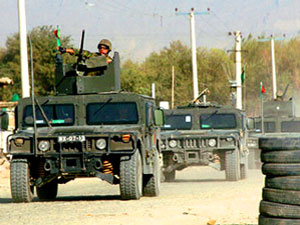Afghanistan: Marines' mission doomed to failure
By Sonali Kolhatkar -New America Media- | Last updated: Jul 23, 2009 - 11:11:43 PMWhat's your opinion on this article?

|
The United States' new offensive into Afghanistan's troubled Helmand province provides a test case for achieving President Obama's stated goal: “to disrupt, dismantle, and defeat Al Qaeda in Pakistan and Afghanistan.”
It is the first major push of its kind, relying on a massive ground presence of thousands of Marines rather than air strikes, which American strategists acknowledge have killed far too many civilians over the past two years. But while Operation Khanjar realizes Washington's increased desire to divert more “resources” into Afghanistan, it is unclear what, if anything, can be accomplished by this kind of brute force.
At the launch of the offensive, U.S. General Stanley McChrystal gave only the following explanation: that his intention is to “clear, hold and build” in Taliban strongholds like Helmand.
But what exactly does “clear” mean? If it means to kill, the U.S. Marines will have to distinguish between Taliban and non-Taliban Afghans to avoid more civilian casualties. This is a near-impossible task. The Taliban do not wear a uniform or carry membership cards. They carry weapons, but so do Afghan civilians, who do so to protect their families. In an effort to lower the embarrassing count of civilians killed (often greater than the numbers killed by the Taliban), McChrystal has ordered troops to cut short any pursuit of Taliban fighters if civilians are at risk.
Perhaps by “clear,” McChrystal means capture. But that raises more difficult questions: Where will they put the prisoners, and what sort of justice will be offered? Will the United States turn Bagram into a greater gulag than Guantanamo? Will they turn over those who survive their torture and interrogation to secret military tribunals? In releasing 90 percent of those imprisoned at Guantanamo without charge, the United States has already proved inept at distinguishing Al Qaeda and Taliban members from ordinary civilians over the past eight years. Imprisoning and torturing innocent civilians has the same obvious effect as killing them: increased hostility and resentment toward the occupation.
Perhaps by “clear,” McChrystal simply means pushing the Taliban out of the areas where they are operating into surrounding areas. Already there are reports that the Taliban have escaped the current offensive, simply retreating to the western and northern parts of the country and launching their own counter-operation: Iron Net, intended to trap the U.S. forces. They have killed dozens of troops and civilians through roadside and suicide bombs in a single week. In response, the United States has reportedly fallen back on the discredited strategy of air raids to kill dozens of people they claim are “militants,” but likely include civilians.
If the current strategy does result, intentionally or not, in displacing the problem into new areas, presumably more Marines will have to be deployed to those areas to repeat the cat-and-mouse game, and push the Taliban up against borders that they cannot infiltrate.
But Afghanistan is not a small country (it is comparable in size to Iraq) and by this logic, the United States is looking at a long-term blanket occupation of the country, something that ordinary Afghans have increasingly declared they do not want.
A BBC-ABC News poll conducted prior to the current ground offensive revealed that less than 50 percent of Afghans have a favorable opinion of the United States, down from 68 percent in 2005. (The poll also revealed an even greater dislike of the Taliban, meaning that Afghans tolerate the U.S. military only because they have no other options.)
The likelihood of American success in Afghanistan is at best dim and, at worst, heading inevitably toward a lose-lose situation. Given the impossibility of surgically identifying and killing a moving and elusive target, there are only two possible outcomes: killing a lot of civilians, or pushing the insurgency to the rest of the country, or both. After the Iraq debacle, are Americans ready for yet another unpopular occupation, protracted war and thousands of U.S. casualties?
Perhaps the name is apt: the United States' Operation Khanjar is named for an Arabic (not Afghan) dagger widely used in past centuries by fighters in the Gulf Arab region, in countries like Oman. But today, the Khanjar is largely a ceremonial weapon, a decorative objet d'art used to adorn walls but useless in a real fight. Like the Khanjar, the current U.S. strategy in Afghanistan, out-of-touch with reality, is more symbolic than practical.
(NAM contributor Sonali Kolhatkar is co-director of the Afghan Women's Mission and co-author of the book Bleeding Afghanistan: Washington, Warlords, and the Propoganda of Silence.)
INSIDE STORIES AND REVIEWS
-
-
About Harriett ... and the Negro Hollywood Road Show
By Rabiah Muhammad, Guest Columnist » Full Story -
Skepticism greets Jay-Z, NFL talk of inspiring change
By Bryan 18X Crawford and Richard B. Muhammad The Final Call Newspaper @TheFinalCall » Full Story -
The painful problem of Black girls and suicide
By Charlene Muhammad -National Correspondent- » Full Story -
Exploitation of Innocence - Report: Perceptions, policies hurting Black girls
By Charlene Muhammad -National Correspondent- » Full Story -
Big Ballin: Big ideas fuel a father’s Big Baller Brand and brash business sense
By Bryan Crawford -Contributing Writer- » Full Story






 Click Here Stay Connected!
Click Here Stay Connected!








